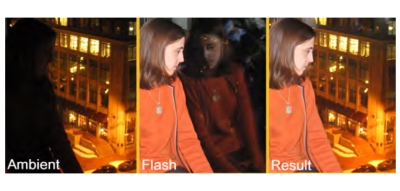TR2005-154
Removing Photography Artifacts using Gradient Projection and Flash-Exposure Sampling
-
- , "Removing Photography Artifacts Using Gradient Projection and Flash-Exposure Sampling", ACM Transactions on Graphics (TOG), Vol. 24, No. 3, pp. 828-835, July 2005.BibTeX TR2005-154 PDF
- @article{Agrawal2005jul,
- author = {Agrawal, A. and Raskar, R. and Nayar, S.K. and Li, Y.},
- title = {{Removing Photography Artifacts Using Gradient Projection and Flash-Exposure Sampling}},
- journal = {ACM Transactions on Graphics (TOG)},
- year = 2005,
- volume = 24,
- number = 3,
- pages = {828--835},
- month = jul,
- issn = {0730-0301},
- url = {https://www.merl.com/publications/TR2005-154}
- }
- , "Removing Photography Artifacts Using Gradient Projection and Flash-Exposure Sampling", ACM Transactions on Graphics (TOG), Vol. 24, No. 3, pp. 828-835, July 2005.
-
Research Area:

Abstract:
Flash images are known to suffer from several problems: saturation of nearby objects, poor illumination of distant objects, reflections of objects strongly lit by the flash and strong highlights due to the reflection of flash itself by glossy surfaces. We propose to use a flash and no-flash (ambient) image pair to produce better flash images. We present a novel gradient projection scheme based on a gradient coherence model that allows removal of reflections and highlights from flash images. We also present a brightness-ratio based algorithm that allows us to compensate for the falloff in the flash image brightness due to depth. In several practical scenarios, the quality of flash/no-flash images may be limited in terms of dynamic range. In such cases, we advocate using several images taken under different flash intensities and exposures. We analyze the flash intensity-exposure space and propose a method for adaptively sampling this space so as to minimize the number of captured images for any given scene. We present several experimental results that demonstrate the ability of our algorithms to produce improved flash images.
Related News & Events
-
NEWS ACM Transactions on Graphics (TOG): 2 publications by Matthew Brand, Amit K. Agrawal and others Date: July 31, 2005
Where: ACM Transactions on Graphics (TOG)
MERL Contact: Matthew BrandBrief- The articles "Face Transfer with Multilinear Models" by Vlasic, D., Brand, M., Pfister, H. and Popovic, J. and "Removing Photography Artifacts Using Gradient Projection and Flash-Exposure Sampling" by Agrawal, A., Raskar, R., Nayar, S.K. and Li, Y. were published in ACM Transactions on Graphics (TOG).